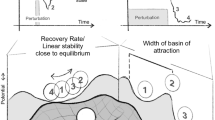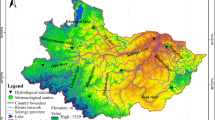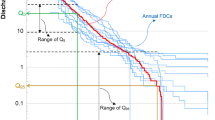Abstract
I have used the Lempel–Ziv measure to assess the complexity in riverflow activity over England and Wales for the period 1867–2002. In particular, I have examined the reconstructed monthly riverflow time series from fifteen representative catchments in these regions and calculated the Lempel–Ziv Complexity (LZC) value for each time series. The results indicate that the LZC values in some catchments are close to each other while in others they differ significantly. In addition, I have divided the period 1867–2002 into four equal subintervals: (a) 1867–1900, (b) 1901–1934, (c) 1935–1968, (d) 1969–2002, and calculated the LZC values for the various time series in these subintervals. It is found that during the period 1969–2002, there is a decrease in complexity in most of the catchments in comparison to the subinterval 1935–1968. This complexity loss may be attributed to increased human intervention involving land and crop use, urbanization, commercial navigation and climatic changes due to human activity. Determining the complexity in the riverflow time series is important because an understanding of the extent of complexity may be useful in developing appropriate models of riverflow activity. The extent of complexity may also influence the predictability of the variability in riverflow dynamics.

Similar content being viewed by others
References
Aboy M, Hornero R, Abasolo D, Alvarez D (2006) Interpretation of the Lempel–Ziv complexity measure in the context of biomedical signal analysis. IEEE Trans Biomed Eng 53:2282–2288
Acreman M (2000) The Hydrology of the UK: a study of change. Routledge, London
Bandt C, Pompe B (2002) Permutation entropy: a natural complexity measure for time series. Phys Rev Lett 88:174102
Costa M, Goldberger AL, Peng CK (2002) Multiscale entropy analysis of physiologic time series. Phys Rev Lett 89:062102
Cover TM, Thomas JA (1991) Elements of information theory. Wiley-Interscience, New York
Falcioni M, Loreto V, Vulpiani A (2003) Kolmogorov’s legacy about entropy, chaos and complexity. Lect Notes Phys 636:85–108
Ferreira FF, Francisco G, Machado BS, Murugnandam P (2003) Time series analysis for minority game simulations of financial markets. Physica A 321:619–632
Gomez C, Hornero R, Abasolo D, Fernandez A, Lopez M (2006) Complexity analysis of the magnetoencephalogram background activity in Alzheimer’s disease patients. Med Eng Phys 28:851–859
Gordon ND, McMahon TA, Finlayson BL, Gipel CJ (2004) Stream hydrology: an introduction for ecologists. Wiley, New York
Graben B, Saddy P, Schlesewsky JD, Kurths J (2000) Symbolic dynamics of event-related brain potentials. Phys Rev E 62:5518–5541
Grassberger P (1991) Information and complexity measures in dynamical systems. In: Atmanspacher H, Scheingraber H (eds) Information dynamics. Plenum Press, New York
Hu J, Gao J, Principe JC (2006) Analysis of biomedical signals by the Lempel–Ziv complexity: the effect of finite data Size. IEEE Trans Biomed Eng 53:2606–2609
Jones PD (1984) Riverflow reconstruction from precipitation data. Int J Climatol 4:171–185
Jones PD, Lister DH (1995) Extended flow records at key locations in England and Wales: Phase 1, Project Report for 512/2/N&Y, National Rivers Authority, Bristol
Jones PD, Lister DH (1997) Extended flow records at key locations in England and Wales, Phase 2, R&D Technical Report W25, Environment Agency, Bristol
Jones PD, Lister DH (1998) Riverflow reconstructions and their analysis on 15 catchments over England and Wales and an assessment of hydrologic drought since 1865. Int J Climatol 18:999–1013
Jones PD, Lister DH, Kostopoulo E (2004) Science report: reconstructed river flow series from 1860 to present. Environmental Agency, Rio House, Bristol
Kantz H, Schreiber T (2004) Nonlinear Time Series Analysis. Cambridge University Press, Cambridge
Krasovskaia I (1998) Entropy-based grouping of river flow regimes. J Hydrol 202:173–191
Lempel A, Ziv J (1976) On the complexity of finite sequences. IEEE Trans Inform Theory 22:75–81
Li Z, Zhang YK (2007) Multiscale entropy analysis of Mississippi riverflow. Stoch Environ Res Risk Assess. doi:10.1007/s00477-007-0161y
Mays DC, Faybishenko BA, Finsterle S (2002) Information entropy to measure temporal and spatial complexity of unsaturated flow in heterogeneous media. Water Resour Res 2001WR00185
Orr HG, Carling PA (2006) Hydro-climatic and land use changes in the river Lune catchment, North West England, implications for catchment management. River Res Appl 22:239–255
Pandey G, Lovejoy S, Schertzer D (1998) Multifractal analysis of daily river flows including extremes for basins of five to two million square kilometers, on day to 75 years. J Hydrol 208:62–81
Pincus SM (1995) Approximate entropy as a complexity measure. Chaos 5:110–117
Porporato A, Ridolfi L (1997) Nonlinear analysis of river flow time series. Water Resour Res 33:1353–1367
Porporato A, Ridolfi L (2003) Detecting determinism and nonlinearity in river flow time series. Hydrol Sci J 48:763–780
Porporato A, Ridolfi L (2001) Multivariate nonlinear prediction of river flows. J Hydrol 248:109–122
Radhakrishnan N, Wilson JD, Loizou PC (2000) An alternate partitioning technique to quantify the irregularity of complex time series. Int J Bifurc Chaos 10:1773–1779
Ramankutty N, Foley JA (1999) Estimating historical changes in global land cover: croplands from 1700 to 1992. Global Biogeochem Cycles 13:997
Regonda S, Sivakumar B, Jain A (2004) Temporal scaling in river flow: can it be chaotic? Hydrol Sci J 49:373–385
Richman JS, Moorman JR (2000) Physiological time-series analysis using approximate entropy and sample entropy. Am J Physiol Heart Circ Physiol 278:H2039–H2049
Rosso OA, Martin MT, Plastino A (2002) Brain electrical activity analysis using wavelet based informational tools. Physica A 313:587–609
Sello S (2000) Wavelet entropy as a measure of solar cycle complexity. Astron Astrophys 363:311–315
Sen AK (2007) Multifractality as a measure of complexity in solar flare activity. Sol Phys 241:67–76
Shannon CE (1948) A mathematical theory of communication. Bell Syst Tech J 27:379–423, 623–656
Singh VP (1997) The use of entropy in hydrology and water resources. Hydrol Processes 11:587–626
Sivakumar B, Jayawardena AW, Li WK (2007) Hydrologic complexity and classification: a simple data reconstruction approach. Hydrol Processes 21:2713–2728
Small M (2005) Applied nonlinear time series analysis: applications in physics, physiology and finance. World Scientific, Singapore
Starck J-L, Murtagh F, Querre P, Bonnarel F (2001) Entropy and astronomical data analysis. Astron Astrophys 368:730–746
Stoop R, Stoop N, Bunimovich L (2004) Complexity of dynamics as variability of predictability. J Stat Phys 114:1127–1137
Szczepaski, Amigo JM, Wajnryb E, Sanchez-Vives MV (2003) Application of Lempel–Ziv complexity to the analysis of neural discharges. Network Comput Neural Syst 14:335–350
Ward AD, Trimble SW (2004) Environmental hydrology. CRC Press, Boca Ratan
Wright CE (1978) Synthesis of river flow from weather data. Technical Note No. 26, Central Water Planning Unit, Reading, UK, p 118
Zhang XS, Roy RJ, Jensen EW (2001) EEG complexity as a measure of depth of anesthesia for patients. IEEE Trans Biomed Eng 48:1424–1433
Ziv J, Lempel A (1978) Compression of individual sequences via variable-rate coding. IEEE Trans Inf Theory IT-24:530–536
Zozor S, Ravier P, Buttelli O (2005) On Lempel–Ziv complexity for multi-dimensional data analysis. Physica A 345:285–302
Acknowledgments
I would like to thank Elizaveta Klempner for technical assistance. I would also like to thank the anonymous reviewers for their insightful comments.
Author information
Authors and Affiliations
Corresponding author
Appendix
Appendix
1.1 Calculation of Lempel–Ziv complexity
In their original work, Lempel and Ziv (1976) developed a measure of complexity to estimate the degree of disorder or irregularity in a sequence. The procedure consists of enumerating the repeating subsequences of all lengths using a complexity counter. For a time series, this is done by first creating an appropriate sequence by partitioning the time series. The Lempel–Ziv complexity analysis of a time series {x i }, i = 1, 2, 3, …, N, can be carried out as follows. First, encode the time series by constructing a sequence S of the characters 0 and 1 written as: s(i), i = 1, 2, 3, …, n, according to the rule:
Here x * is a chosen threshold. I shall choose the mean value of the time series to be the threshold. The mean value of the time series has often been used as the threshold (Zhang et al. 2001). Depending on the application, other encoding schemes are also used (Radhakrishnan et al. 2000; Small 2005).
To start the computation, the original sequence is scanned from left to right and a complexity counter c(n) is increased by one unit every time a new subsequence of consecutive characters is encountered. The complexity counter measures the number of distinct patterns contained in a given sequence. With this procedure the Lempel–Ziv complexity measure (LZC) can be computed using the following steps (see Gomez et al. 2006; Zhang et al. 2001).
-
1.
Let P and Q denote two subsequences and PQ be the concatenation of P and Q. In addition, let PQπ be a sequence derived from PQ after its last character is deleted. Here the symbol π is used to denote the operation of deleting the last character in a sequence.
-
2.
Let v(PQπ) denote the vocabulary of all different subsequences of PQπ.
-
3.
At the beginning of the computation, the complexity counter is set to be one, i.e., c(n) = 1, with P = s(1), Q = s(2), PQ = s(1), s(2), and PQπ = s(1).
-
4.
In general, P = s(1), s(2), …, s(r), and Q = s(r + 1). Then PQπ = s(1), s(2), s(3), …, s(r). If Q belongs to v(PQπ), then Q is a subsequence of PQπ, not a new sequence.
-
5.
Renew Q to be s(r + 1), s(r + 2) and see if Q belongs to v(PQπ).
-
6.
Repeat the previous steps until Q does not belong to v(PQπ). In this case, Q = s(r + 1), s(r + 2), …, s(r + i) is not a subsequence of PQπ = s(1), s(2), …, s(r + i − 1); so increase the counter by one.
-
7.
Thereafter, P is renewed to be the sequence: P = s(1), s(2), …, s(r + i), with Q = s(r + i − 1).
-
8.
Repeat the previous steps until Q is the last character. At this point, the complexity counter c(n) gives the number of different subsequences in P, which is equal to the Lempel–Ziv complexity (LZC).
Note that the above procedure uses only two operations: comparison and accumulation, and this makes the computation of c(n) easy to implement.
A Lempel–Ziv complexity measure which is independent of the length of the sequence can be obtained by normalizing c(n) with respect to the complexity of a random binary sequence: \( b(n) = n/ \log _{2} n \). The normalized LZC measure is given by
This normalized measure is used for estimating the LZC values in the present study. For a deterministic system that is composed of well defined cycles such as a periodic motion, C(n) has a value much smaller than 1, whereas for a stochastic system, the value of C(n) is close to 1.
Rights and permissions
About this article
Cite this article
Sen, A.K. Complexity analysis of riverflow time series. Stoch Environ Res Risk Assess 23, 361–366 (2009). https://doi.org/10.1007/s00477-008-0222-x
Published:
Issue Date:
DOI: https://doi.org/10.1007/s00477-008-0222-x




